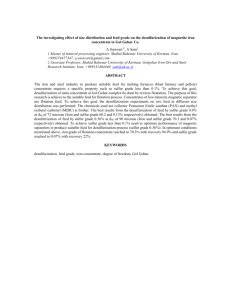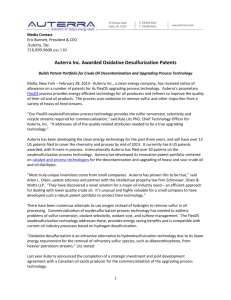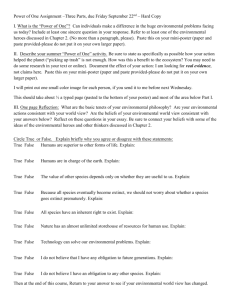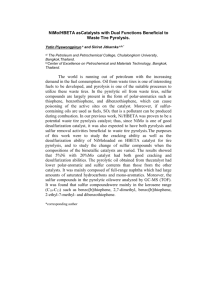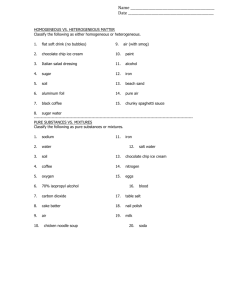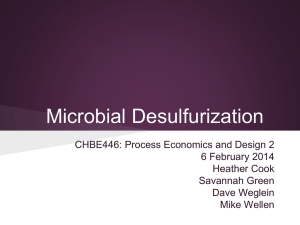The Removal of Sulfur from the Recycling of Used Lead Acid Batteries
advertisement
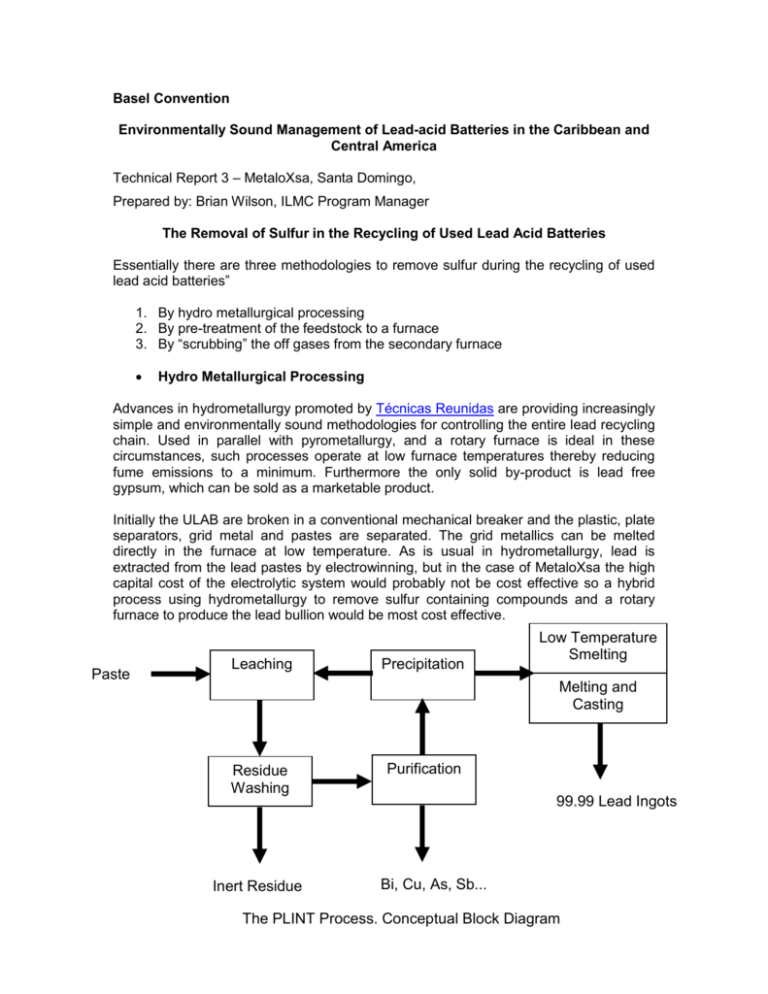
Basel Convention Environmentally Sound Management of Lead-acid Batteries in the Caribbean and Central America Technical Report 3 – MetaloXsa, Santa Domingo, Prepared by: Brian Wilson, ILMC Program Manager The Removal of Sulfur in the Recycling of Used Lead Acid Batteries Essentially there are three methodologies to remove sulfur during the recycling of used lead acid batteries” 1. By hydro metallurgical processing 2. By pre-treatment of the feedstock to a furnace 3. By “scrubbing” the off gases from the secondary furnace Hydro Metallurgical Processing Advances in hydrometallurgy promoted by Técnicas Reunidas are providing increasingly simple and environmentally sound methodologies for controlling the entire lead recycling chain. Used in parallel with pyrometallurgy, and a rotary furnace is ideal in these circumstances, such processes operate at low furnace temperatures thereby reducing fume emissions to a minimum. Furthermore the only solid by-product is lead free gypsum, which can be sold as a marketable product. Initially the ULAB are broken in a conventional mechanical breaker and the plastic, plate separators, grid metal and pastes are separated. The grid metallics can be melted directly in the furnace at low temperature. As is usual in hydrometallurgy, lead is extracted from the lead pastes by electrowinning, but in the case of MetaloXsa the high capital cost of the electrolytic system would probably not be cost effective so a hybrid process using hydrometallurgy to remove sulfur containing compounds and a rotary furnace to produce the lead bullion would be most cost effective. Paste s Leaching Precipitation Low Temperature Smelting Melting and Casting Residue Washing Inert Residue Purification 99.99 Lead Ingots Bi, Cu, As, Sb... The PLINT Process. Conceptual Block Diagram In the hybrid process a pure lead compound, lead hydroxide, is precipitated and charged to the furnace where it decomposes to produce pure lead bullion and water vapor. The PLINT process can also process fume as well as lead refining and oxide production drosses. In fact the hydrometallurgical processing of baghouse fume is the most efficient way to recover the lead in this by-product. The hydrometallurgical Process is as follows: 1. Leaching with make-up hydrochloric or sulphuric acid: PbO + 2 HCl + 2 NaCl = PbCl4Na2 + H2O PbSO4 + 4 NaCl = PbCl4Na2 + Na2SO4 PbO2 + Pb0 + 2 HCl + 4 NaCl = 2 PbCl4Na2 + 2 H2O PbO + H2SO4 + 2 CaCl2 = PbCl4Ca + CaSO4 + H2O PbO2 + Pb0 + 2 H2SO4 + 2 CaCl2 = 2 PbCl4Ca + CaSO4 + 2 H2O 2. Purification with lead powder MeCln + Pb0 + 2 NaCl = PbCl4Na2+ Me0 Where Me = Bi, Cu, Ag... 3. Precipitation of lead hydroxide concentrate PbCl4Ca + Ca(OH)2 = Pb(OH)2 + 2 CaCl2 PbCl4Na2 + Ca(OH)2 = Pb(OH)2 + 2 NaCl + CaCl2 The decomposition of the lead hydroxide in the Rotary furnace will produce 99.99% pure lead bullion and certainly reduce or eliminate the amount of refining required prior to casting. Indeed the amount of refining will largely depend on the amount of grid metallic contamination left in the furnace after a melting campaign. With this in mind it is probably worth considering running extended campaigns of alternate grid metal and lead hydroxide charges to reduce the amount of contamination to a pure lead bullion. Leaching efficiency in the hydrochloric acid and brine solution can be expected to be 99.4 to 99.7%. Please note that this hybrid process does not require a separate desulfurization stage. Any sulfur present in the paste or the electrolyte is removed using lime, which in most countries is about the cheapest material suitable for this purpose, to form gypsum, which is then removed by filtration. Pre-treatment of the feedstock to a furnace Engitec and MA, two of the largest battery breaking manufacturers, recommend pretreatment desulfurization. Essentially the basic desulfurization equations for the conversion of lead sulfate to lead carbonate using soda ash in solution are: PbSO4 (in paste) + Na2CO3(aq.) -> PbCO3(solid) + Na2SO4(aq.) The stoichiometric calculation is: PbSO4 (in paste) 1 mol (207+32+64) 303 + Na2CO3(aq.) -> PbCO3(solid) + Na2SO4(aq.) + 1 mol -> 1 mol+ 1 mol + (46+12+48) + 106 -> (207+12+48) -> 267 + (46+32+64) + 142 i.e. 303 tons of lead sulfate paste requires 106 tons of soda ash to desulferize. I.e. I ton of lead sulfate paste requires 0.35 tons of soda ash and 100 tons of lead sulfate paste requires 35 tons of soda ash and 100 tons of PRI paste at 60% lead sulfate requires 21 tons of soda ash As there is always sulfuric acid present in the paste after the batteries have been broken in the Battery Breaker, even if the paste is dewatered, and commercial soda ash is only about 92% sodium carbonate, a 20% excess (and some companies such as Engitec recommend up to 50% excess) of soda ash is required in solution, ie. approximately 25 tons (or up to 31 tons). Method of desulfurization vary and some companies are desulferizing at pH 9.5 to 10. Ideally the desulfurization process will produce predominetly lead carbonate and this is the case at a pH value of 8 to 8.5, but at a pH value of 10 the predominant product will tend to be hydrocerussite, Pb3(CO3)2(OH)2 rather than PbCO3 and the stoichiometric calculation changes accordingly: 3PbSO4(paste)+ 2Na2CO3(aq.)+ 2H2O -> Pb3(CO3)2(OH)2(solid) +2Na2SO4(aq.)+ H2SO4 The stoichiometry is: 3PbSO4(paste)+ 2Na2CO3(aq.)+ 2H2O -> Pb3(CO3)2(OH)2(solid) +2Na2SO4(aq.)+ H2SO4 3 mols + 2 mols + 2 mols-> 1 mol + 2 mols + 1 mol 3(207+32+64) + 2(46+12+48) + 36 909 + 190 + 36 ie. or and and -> (621+2(12+48)+2(16+1))+2(46+32+64) + 98 -> 776 + 206 + 98 909 tons of lead sulfate paste requires 190 tons of soda ash to desulferize. I ton of lead sulfate paste requires 0.21 tons of soda ash 100 tons of lead sulfate paste requires 21 tons of soda ash 100 tons of battery paste at 60% lead sulfate requires 12.6 tons of soda ash Because sulfuric acid present in the paste after the batteries have been broken in the Breaker, a 20% excess (and some companies such as Engitec recommend up to 50% excess) of soda ash is required in solution, ie. 15 tons (or up to 19 tons). Normally the industrial process pH range for desulfurization is pH 8 to 8.5 and certainly no more than a pH of 9. The process temperature would be about 35 to 40o Celsius. As the reaction progresses and lead carbonate is produced, the paste mix becomes increasingly viscous. It is very important to maintain agitation in the reaction vessel. If agitation is not vigorous the reaction will stall and much of the lead sulfate will remain suspended in the mix. If agitation cannot be increased, it might be necessary to recirculate the paste mix through the transfer pump back into the reaction vessel in order to mix the reagents in the pump. There are two schools of thought for the ideal temperature for desulfurization . While some companies desulferize between 35 and 42 degees Celcius, some US plants will desulferize at about 50 to 54 degrees Celcius. The higher temperature has been adopted to overcome the low solubility of sodium carbonate and is accommpanied with higher agitation rates as the reaction is that much quicker. It is important to remove the excess sodium carbonate by washing the paste and subjecting it to either a vacuum or gravity moisture extraction process prior to feeding the material to the furnace. Typical scrap US battery paste comprises of: Lead metallics PbO + PbO2 PbSO4 1 - 5% 20 - 25% 55 - 60% Some secondary plants in the US report desulfurization rates as low as 0.2% and others up to a level of 1.5% calculated above is not uncommonly high bearing in mind that sodium carbonate will form double sodium lead salts, NaPb2(CO3)2(OH), escpecially at high pH and with increasing reaction time. Leaching at a higher pH and high sodium carbonate concentrations increases the possibility of the formation of NaPb2(CO3)2(OH) and the carry over of sodium into the furnace operation. Increasingly, if the retention time in the reactor is above 2 hours it will also increase the formation of lead/sodium carbonates. This is undesirable as it increased the propensity to form unstable slags. An alternative to the use of soda ash would be to use 50% sodium hydroxide (NaOH) solution because it has the following advantages: The NaOH content is nearly stoichiometric because the quality of 50% NaOH solutions normally varies between 49 and 51%, whereas commercial soda ash is usually no more than 93% pure and with sodium chloride, a desulfurization reaction inhibitor, as one of the main impurities. The absence of chlorine ions eliminates the need to periodically purge the desulfurization process Solid insoluble salts are not formed The NaOH desulfurization process precipitates a hydrated lead oxide (3PbO.H2O) that is about 12% lighter than the corresponding carbonate. The desulfurized paste can then be filtered in a press and stored prior to drying and charging to the furnace. It is very important that desulfurization efficiency is high because the lower the sulfur burden in the furnace feed material the less the risk that sulfur dioxide emissions from the stack will exceed statutory limits. Moreover improved mixing in the reaction phase of the desulfurization process will reduce the carry over of excess sodium salts to the furnace feed and the final discard slag. Lowering the sodium content of the discard slag will considerably improve slag stability and reduce lead leaching from the slag to the environment. Mixing efficiency has shown to be a function of the amount of turbulence created in the reaction vessel. An adequate stirrer is essential, but it is vital that baffles are fitted to the inside walls of the mixing chamber to generate turbulence as shown below: Baffles Mixing Vessel Stirrer A typical Engitec layout would be: “Scrubbing” the off gases from the secondary furnace If sulfur is not removed in a pre-treatment process described above, then the most appropriate technology for the removal of sulfur dioxide depends on the degree of fixation of the sulfur in the slag and the subsequent formation and the concentration of SO2 produced. For very low strength SO2 off-gases, such a those produced in a secondary rotary furnace a wet or semi-dry scrubber, producing saleable gypsum is most appropriate and considered to be Best Available Technology (BAT). For higher strength SO2 rich off-gases gases, such as those produced in primary lead smelters, there are a number of BAT options such as cold water absorption followed by sulfuric acid plant treatment, and double contact sulfuric acid production. Some of the sulfur present in the raw material feed to the furnace can be incorporated into the slag by the careful addition of iron to the reagent and flux mix. Nevertheless, without pre-treatment de-sulfurization it is unlikely that sufficient sulfur will be fixed in the slag to consistently meet SO2 discharge limits. Hence the need for a “scrubber” or desulfurization tower. There are many absorption media to choose from, but lime still remains one of the cheapest and most effective reagents for the removal of SO2 from flue gas. Lime is more reactive than limestone, and requires less capital to purchase the equipment required. o Wet scrubbing Wet scrubbing systems are used in the secondary lead industry to remove sulfur dioxide at low concentrations, but at the same time they will often be utilized to remove particles and also to control the temperature (by adiabatic cooling) of the gases entering the baghouse dust filtration system. Whilst the basic technology for these applications is similar, the design criteria for particulate and gaseous component removal are very different. Accordingly wet scrubbing systems are often a compromise of competing technologies and significant cross media effects such as the production of additional wastewater may result depending on the priority application. Lime, preferably magnesium-enhanced lime (containing 3-8% magnesium oxide), which provides high alkalinity that increases the SO2 removal capacity and also reduces scaling potential, is added and mixed into the de-sulfurization process water. The resulting slurry is sprayed into a scrubbing tower. The furnace off-gas contaminated with SO2 enters the bottom of the desulfuirzation tower and forced upwards through the shower of lime slurry. The sulfur dioxide is absorbed into the spray solution and slurry mix and then precipitated as wet calcium sulfite. The calcium sulfite can be converted to gypsum, a marketable by-product that can be sold to the cement industry or used in the manufacture of fiber board. Gypsum produced from lime desulfurization is 97-99% pure, bright-white, and capable of being dewatered to less than 10% moisture. Wet Scrubber o Dry scrubbing Dry scrubbing technologies are also available, but they are not as effective as wet or semi-dry scrubbing with less reactive gases such as SO2. Such a desulfurization process is often known as flue gas de-sulfurization and is ideal to remove the final traces of sulfur in the form of SO2 left in the furnace feed material after desulfurization using soda ash in a pre-treatment process. In the dry scrubbing process lime (as an example) is injected directly into the flue gas to remove the SO2. There are two major dry processes: o “dry injection” systems - inject dry hydrated lime into the flue gas ducting . o “spray dryers” inject an atomized lime slurry into a separate vessel. A spray dryer is typically shaped like a silo, with a cylindrical top and a cone bottom. Hot flue gas flows into the top. Lime slurry is sprayed through an atomizer (e.g., nozzles) into the cylinder or vessel near the top, where it absorbs the SO2 and the hot gas evaporates the water in the lime slurry. The scrubbed flue gas flows out of the bottom of the cylindrical section through a horizontal duct. The dried lime and its reaction products fall to the bottom of the cone and are removed. The flue gas then flows to a conventional baghouse to remove the remainder of the lime and reaction products. Both processes yield a dry final product that is collected in particulate control devices. o Alternative Processes There are a number of desulfurization processes that regenerate the solvent medium and release concentrated SO2 that can be processed to elemental sulfur or sulfuric acid. These processes eliminate the solid by-product and the most common processes are: o Wellman-Lord process where sodium sulfite is used as the absorbent medium with SO2 reacting with sodium sulfite and water to produce sodium bisulfite. Concentrated sulfur dioxide can be stripped from this solution and liquid sulfur dioxide produced or even elemental sulfur. Wellman Lord Process o Na2SO3 + SO2 + H2O -> 2NaHSO3 The magnesium oxide process that involves gas/liquid reactions and thermal regeneration of the solvent. Magnesium oxide system MgSO3 + SO2+ H2O -> Mg(HSO3)2 o The sodium sulfite and sodium hydroxide mixed medium has a high SO2 removal efficiency, but also a high capital cost and running expenses. o Magnesium/lime systems can that can achieve up to 96% removal efficiency. o 2,3-dimethylaniline (DMA) (ASARCO process) scrubbing can absorb sulfur dioxide, which is then removed by reaction with water to produce sulfuric acid or liquid sulfur dioxide. o Peracidox process, oxidation with hydrogen peroxide to produce sulfuric acid. Final comments The remaining question is which system is the most appropriate? All the methodologies will desulfurize and all of the processes mentioned are suitable for a secondary lead plant with a Rotary Furnace. However there are some important considerations to take into account when deciding which is the most appropriate desulfurization process: The first point to make is that there is increasing pressure on secondary lead plants to produce stable inert slags, and that means keeping the sodium content of the final residues below 10%. Any excess sodium salts that carry over into the furnace feed material from any pre-treatment desulfurization will increase the sodium content of the slag. Attention must be paid to the pre-treatment desulfurization and that also means that it is advisable to drain the ULAB prior to crushing to reduce the amount of sulfur, in the form of sulfuric acid entering the process. Many secondary lead plants are now washing the desulfurized paste to remove trace amounts of sodium salts. The second point is that process technology is increasingly moving towards sustainable processes, that is those that regenerate the reagents and do not produce residues or waste products that are either dumped into the environment or dispersed in the atmosphere. Of course it goes without saying that regenerative technologies are also very cost effective. Sustainable processes also mean that saleable by-products are produced and in making a decision about which desulfurization technology to choose it is important to ascertain the potential market for any of the by-products. For example, in most of the OECD countries Gypsum is a very marketable byproduct and will attract a good price, but in many developing countries there is no market for gypsum. You will note that in addition to outlining the main desulfurization processes that we discussed during my visit, that is the wet scrubber and the pre-treatment, I have also included the PLINT process. The main advantage with this desulfurization process is that the lead hydroxide produced will decompose when heated in the furnace to produce pure lead bullion and no fume. This is an important consideration when there is pressure from the municipal authorities to reduce the levels of lead exposure. Finally it is important that ULAB are crushed and the components separated prior to smelting the leaded scrap in the Rotary furnace. This particularly applies to the grid metallics which if separated and cleaned of any residual oxides and sulphate paste can be “melted” into the rotary furnace at a low temperature and without significant amounts of fume generated. Good separation will also facilitate efficient desulfurization as the maximum surface area of the lead sulfate is exposed to the reactive ingredient of the process. I hope that this summary is of help to you and please don’t hesitate to get back to me if you have any queries. BW/ILMC/August 1, 2002
